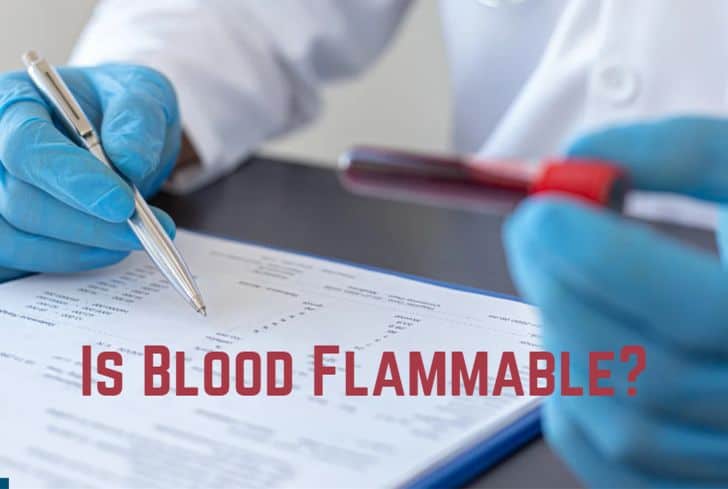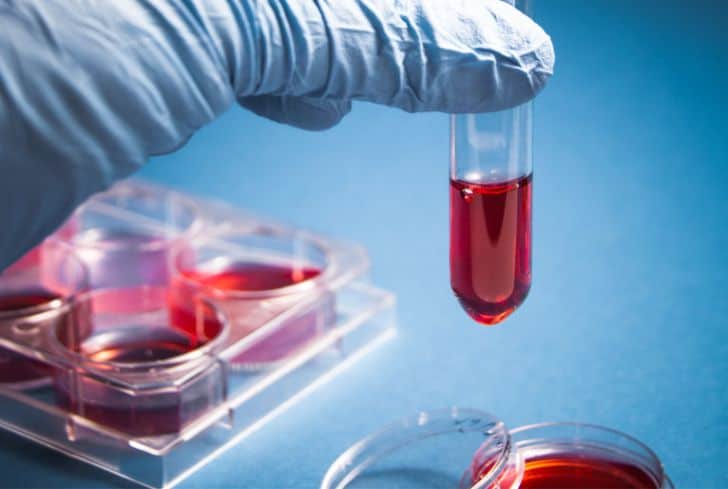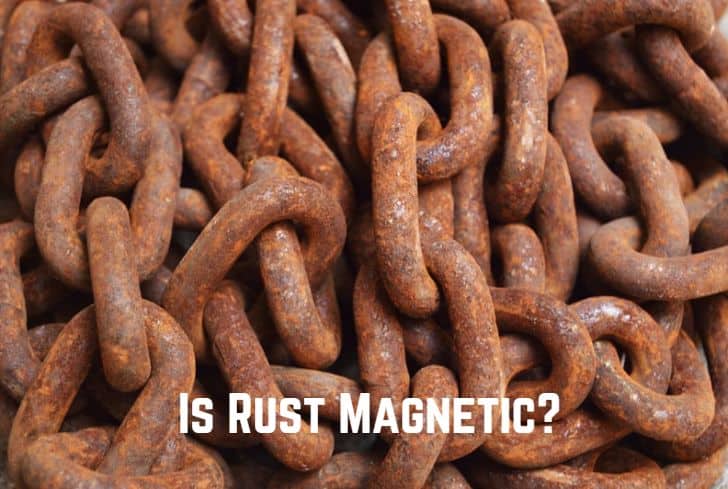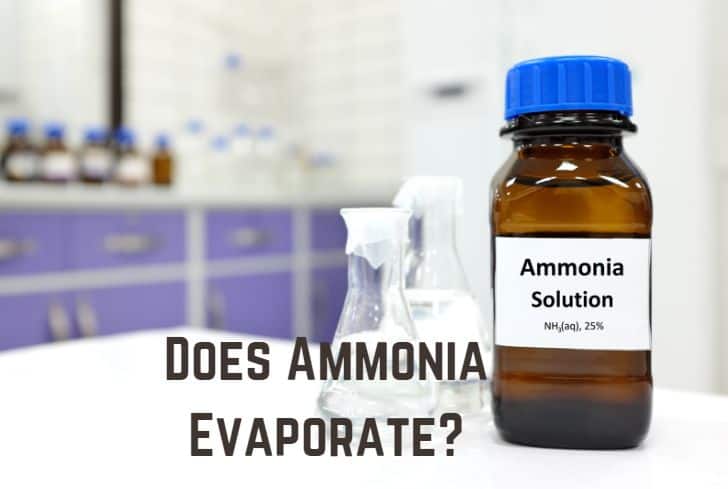Is Blood Flammable? (No. Because…)

Have you ever wondered why someone dies suddenly from excessive bleeding? Any living thing requires blood to survive. It moves throughout the body, giving blood cells oxygen and nutrients. And because most liquids are flammable, is blood one of them? Is blood flammable?
One of the questions we’ll address in this article is that one. Additionally, you will learn blood components, what happens if you set it on fire, and whether alcohol makes blood flammable. We’ll explain spontaneous blood combustion to you if you don’t already know what it is. Finally, we inform you what causes a material to be considered flammable and whether or not blood evaporates.
Read: Is Silver Flammable? (Melting and Boiling Point of Silver)
Is Blood Flammable?
Water makes up the majority of blood, which makes blood non-flammable. Water will immediately put out any fire. 60% of blood is made up of plasma, which is primarily made up of 92% water. Plasma is a poor burning fuel. The critical factor preventing blood from igniting is the existence of hemoglobin, which has a low oxygen affinity.
Oxygen is carried by red blood cells all over the body. Blood oxidizes when it is exposed to oxygen, and it turns red. The heat generated by oxidation is insufficient to ignite the blood.
The blood’s other components cannot support fire. Proteins, including albumin, fibrinogen, and hemoglobin, have huge, difficult-to-ignite molecules.
What is Blood Made up of?
Your blood’s primary function is to transport nutrients and oxygen. It is also responsible for removing waste from your metabolic system. Only your body can create blood; there is no artificial alternative. Blood is mainly made up of four substances:
- Plasma
The blood’s liquid fluidity is a result of plasma. Hormones, enzymes, antibodies, and other substances make up most of the plasma. A transparent fluid called plasma is used to transport cells and platelets. Approximately 55% of blood is made up of plasma.
- White blood cells
The cell aids in the defense against viruses, bacteria, and other pathogens. They support your body’s immune system and are the least blood-soluble.
- Red blood cells
Hemoglobin, a component of red blood cells, binds to oxygen and transports it from the lungs to other body regions, turning it into energy. They replace out damaged, aging cells with new ones.
About 45% of your blood is made up of red blood cells. Every hour, your body creates 4 billion new blood cells. They live for 120 days before dying and being excreted.
- Platelets
If your body sustains an injury, the platelets, tiny cell fragments, aid in the blood’s ability to thicken and clot. It effectively binds the wound, enabling healing.
Why is Blood Not Flammable at All?
Since its primary components are liquids, blood is entirely inflammable. The primary ingredient, water, does not burn and will put out a fire. Plasma, white and red blood cells, and dissolved salts are non-flammable components. A coating on the cells keeps them from catching fire. Even oxygen in the blood is insufficient to render it flammable.
Blood is made up of numerous components that lack the proper molecules to enable burning. It becomes flammable when blood is mixed with oil or other substances. However, such instances only occur under unique situations, like lab settings.
Blood was used as a fire extinguisher during World War II. These protein-based foam fire extinguishers put out class B liquid flames. However, a lot of firefighters think that’s outdated.
What Happens When You Set Fire to Blood?
All the water first disappears when you burn blood. Essential organic compounds make up the majority of the remaining components. Only nitrogen, oxygen, carbon, and sometimes some trace elements are left after the total or partial evaporation of the water. These substances will burn if the fire is hot enough. Burnt blood turns a deep red color.
Blood is not flammable, yet it can be a fuel source under the right circumstances. It can catch fire with an oxidizing substance like oxygen or hydrogen peroxide. Burning blood often has a weaker, more muted smell than burning flesh. In a significant part, burning blood will smell like frying meat if you get closer to it.
Compared to wet blood, dry blood is more flammable. Minerals, hemoglobin, proteins, and lipids are the only things left once all the water has gone. Dried blood will require some heat to ignite if you try to burn it in a fire. It will burn with a highly smokey flame once it starts. Dried blood comprises proteins and lipids, which makes the flame smoky and weak.

Will Alcohol Make Blood Flammable?
A material must have 35–40% volume of alcohol to be flammable. 50% of your blood must contain alcohol for it to ignite. A blood alcohol content of 0.08% disqualifies you from operating a motor vehicle. You’ll probably pass away when your blood alcohol content (BAC) reaches 0.5%. Alcohol cannot, therefore, cause blood to catch fire.
Hence your blood can’t have a blood alcohol concentration of up to 50%. Additionally, your blood will not come into contact with flames because it is safely kept within your body. If you witness a drunk person on fire, their clothes probably caught fire rather than the alcohol in their system.
Alcohol and blood outside of your body, however, increase the likelihood of burning.
What is Spontaneous Human Combustion (SHC)?
Our bodies are primarily constituted of water and other substances that burn slowly. However, there are also situations where a body can burn to death without any fire. “Spontaneous human combustion” is the name given to the condition (SHC). Without an outside spark, a chemical reaction inside the human body causes it to catch fire.
In human bodies, this phenomenon can be fuelled by body fat. You can use this example to understand this condition better.
Read: Is Resin Flammable? (Does It Catch Fire?)
A heavy drinker and cigarette smoker choose to watch a Netflix movie. Sadly, they nod out, causing the lit cigarette to land on their body. The cigarette penetrates the epidermis and burns through to the bodily fat. Remember that body fat is similar to oil. Body fat is flammable, much like regular oil, and might set other body parts ablaze.
Several bodies that had been burned to death and had no visible source of fire were discovered in previous centuries. The furniture and other items in the room where the victims were found did not have signs of burning.
Read one such case: A real story of spontaneous human combustion.
Most scientists have used the “wick” theory to explain further SHC, disputing the claims that the human body can burn without a heat source. The victim’s body is a flammable material, and their hair or clothing is a wick. The heat from the body melts the body fat, which soaks into the clothing and serves as fuel to keep the fire going—the primary cause of the victim’s body burning while their surroundings are unaffected.
What Makes a Material Flammable?
A substance is flammable if it burns quickly and easily without heating up. Most of the time, oxygen is required for a chemical to burn. Even if a substance was previously burning, depriving oxygen will cause it to stop. Additionally, dry materials burn more quickly than moist ones. For instance, dry wood burns more rapidly than damp wood. Moisture will prevent fire from starting as well.
Below are some more factors which contribute to a material’s flammability.
- They give forth vapors continuously and quickly evaporate. The materials’ fumes will catch fire and burn.
- They contain a significant amount of carbon and hydrogen.
- The substance typically has weak and easily breakable molecular bonds. When the bonds are broken, the substance will quickly catch fire.
However, don’t be surprised to learn that the material is not uniformly flammable. A single naked flame can cause distinct reactions in various areas of the same substance. For instance, they all respond differently when you try to burn sawdust, paper, or wooden furniture. The furniture will burn over a long period.
Read: Is Olive Oil Flammable? (Can It Catch Fire?)
Does Blood Evaporate?
Blood does evaporate. It dries out and evaporates, leaving behind crystals like calcium oxalate and uric acid. Water makes up 92% of blood plasma, and water is known to evaporate quickly under heated conditions. But don’t worry, for blood to evaporate from your body, it must reach its boiling point of 212°F (100°C).
You will have had a heat stroke before your blood can reach that temperature. At about 105.8°F (41°C), heat stroke will occur. Astronauts use specialized suits to manage the pressure around their bodies because blood can evaporate at such temperatures.
However, if you choose to boil blood and it reaches these temperatures, all that is left is:
- Charred red blood cells,
- Proteins,
- White cells,
- Platelets.
The blood’s melting lipid creates an oily environment for the four components. They become crystals when the temperature increases further.
Conclusion
Blood cannot evaporate because it contains too much water and other liquids. It is difficult for a fire to begin burning when there is water. The water component will melt first if you accidentally burn blood, leaving you with the remaining components. Crystals will form from the remaining components.






